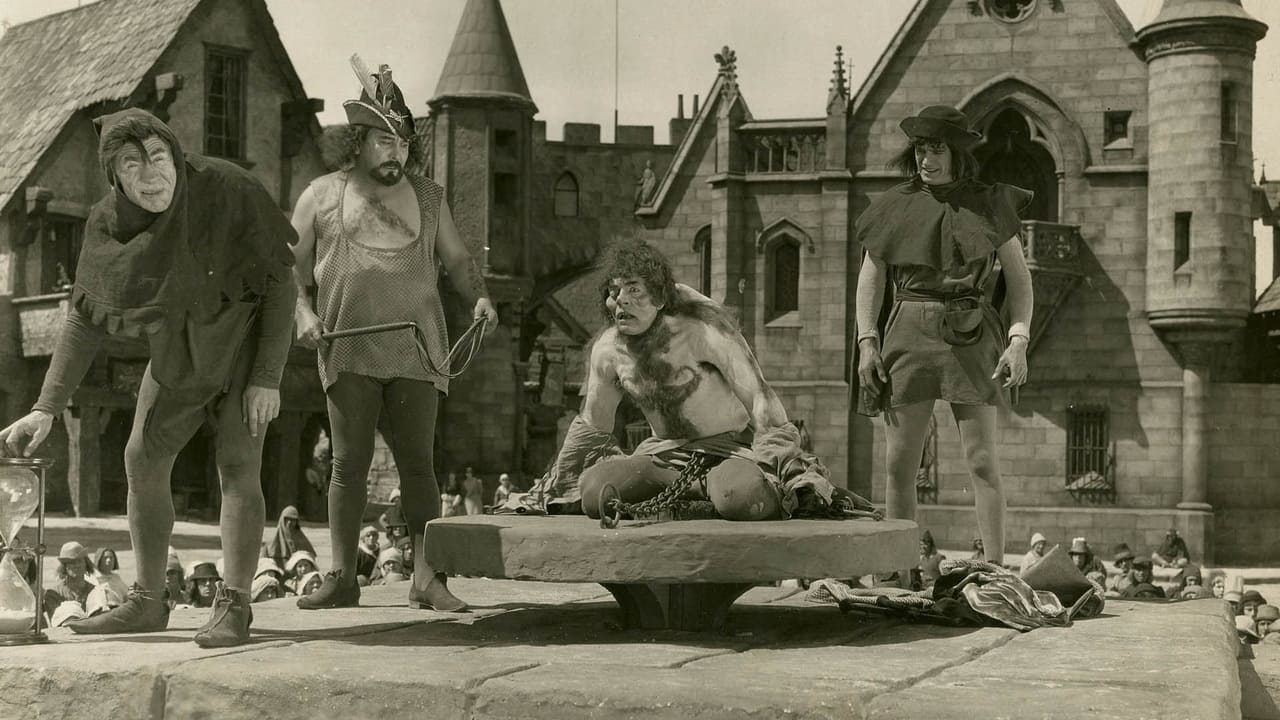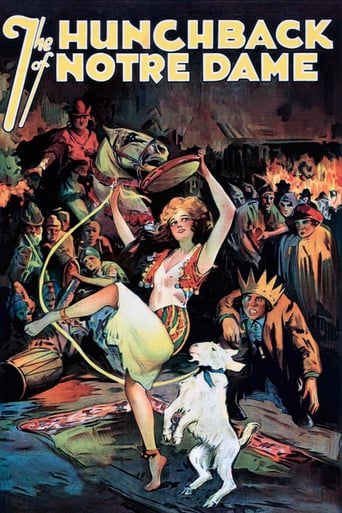

Wallace Worsley is not a director who usually figures in any lists of Hollywood masters. In fact, Chaney himself (with whom Worsley worked on no less than five pictures-this is the last of them) once described Worsley as little more than "good as any of the second-raters or better." Well Hunchback is certainly better. A whole lot better! A staggeringly spectacular production, its huge crowds and sets are most artistically angled and photographed. If Wallace Worsley was responsible for these consistently pleasing arrangements of light and color, he is indeed a neglected master. Ironically, it was due to the fact that he had worked successfully with Chaney at other studios that Worsley was hired in the first place, whereas Chaney's own preference was for Frank Borzage. Although Hunchback was a rousing success, Worsley was not offered any more work at Universal. In fact, the studio's publicity department regarded Worsley as such a has-been, they didn't even bother to spell his name correctly on the elaborately colorful posters prepared for the film's general release. (They managed to get Lon Chaney's name right though). In 1924, Worsley followed his Hunchback by directing a minor William Farnum/Lois Wilson vehicle, The Man Who Fights Alone, for Paramount. After that little stint, Paramount's publicity manager, B.P. Schulberg-who had Clara Bow under personal contract, plus his own personal production company(!)-releasing through Paramount of course-hired Worsley for The Shadow of the Law, a no-frills quickie that had only two claims to fame: It starred Miss Bow and was photographed by Ray June. And then came Worsley's final movie, appropriately titled The Power of Silence (1928), an out-of-date Belle Bennett silent from Tiffany-Stahl of Poverty Row. In addition to his creative visual artistry, Wallace Worsley was also adept at drawing fine performances from his players. Chaney is most effective, Miss Miller utterly charming; while Ernest Torrence, Raymond Hatton and Brandon Hurst almost steal the movie. Tully Marshall would certainly figure on this list too if his role were larger. The only weak spots are Nigel de Brulier, who is mostly quite credible but inclined to overdo the dramatics at times, and Norman Kerry who yet makes his hero considerably less abysmal here than his later effort in Phantom of the Opera. However it is not the actors, or even Mr Chaney, who constantly engage our attention. It is the overwhelming sets, filled with merry-making and murderous crowds-the whole medieval milieu in fact that Wallace Worsley brings so forcefully and dramatically to life. AVAILABLE on DVD through Image in a beautifully tinted 117-minute print, well-worn in places but always admirably sharp.
... View More. . . as the main villain of Victor Hugo's original novel, Capt. Phoebus, GETS THE GIRL HERE, and poor Quasimodo dies of knife wounds and falling 150 feet, NOT romantically of a broken heart in the arms of his beloved, Esmeralda, as is the case in the REAL, better plot line. But as Hollywood illustrated more recently in the Demi Moore remake of THE SCARLET LETTER, they've never been unwilling to hire "writers" with second-grade educations to "improve" master works by literary giants such as Hugo, Nathaniel Hawthorne, Joseph Conrad, Mark Twain, Washington Irving, William Shakespeare, Margaret Mitchell, James Fenimore Cooper, Charles Dickens, and whoever else is in that famous deck of cards. Poll the American public on how many kids Scarlett O'Hara had in real life, and 99% of the answers would be "one"--since that's the number shown on-screen during the four hours of GONE WITH THE WIND, and the percentage of movie watchers too lazy to read an 1,100-page book and willing to trust Hollywood would NOT leave out anything important in a flick titled after a seminal book, such as Scarlett's OTHER kids! Now I'm not saying that I would be anymore up for a goat hanging than the next person, but it's certainly more than irritating to have director Wallace Worsley and the writing team of Perley Sheehan-Edward Lowe, Jr. turn Hugo's pathos into Disney cartoon-like bathos.
... View MoreThe literary Gothic was, partly at least, architecture—exploitation—and not only at the pair of French authors—Hugo and Leroux—but at the British and even German masters as well . Both Hugo and Leroux developed, each in his own way, this brand of architecture—exploitation, the romance of a building. Hugo did this for the medieval Paris (--and for the 19th century, when chronicling Valjean's exploits --), Leroux for the 19th century Paris; a hack like Kate Mosse is, nowadays, in the same vein. Architecture—inspired romance, novel that drives its inspiration from architectural masterpieces (--or, at least, emblematic buildings--). It corresponded to the vague animism of the Gothic/ Romantic project; at the very best, it means atmosphere.It is a pleasure to get acquainted to the sexy divas of the ancient cinema—albeit by means of silent footage only; in previous entries here we spoke about Mss Mary Philbin and Priscilla Dean, now we are glad to meet Mrs. Patsy Ruth Miller—as you might of guessed (Patsy Miller might not be a stunning name for a movie diva, yet Ruth gives it the Biblical note of use to promote the babe to stardom). What these three babes have in common—other than their beauty, and being divas of the silent movies, and living rather long lives, as Philbin made it till '93 (89 yrs), Dean till '87 (91 yrs), and Miller till '95 (91 yrs)—is that they all have been Chaney's movie partners.Mrs. Patsy Ruth Miller was 19 in this movie. She did movie roles in the '20s; then she wrote, and for a time played on Broadway.The Hunchback is a romance imagined by a young man 27—28 yrs. old, in 1829—30. It is one of the most spectacular and finely achieved Gothic romances.As for the movie itself, like many other silent movies it is characterized by a basic plain commonsense realism that has vanished since from the Hollywoodian cinema.The Hugolian masterpiece has been rather often brought to screen, and the Chaney version is one of the loveliest and most successful in terms of art, admirably paced (especially with such a wealth of epic) and lively—watch how nicely it introduces the major characters—and this way you notice how MANY strong characters the Hugolian romance has—Quasimodo, the Archdeacon Claude Frollo (--they won't explain it to you, but an Archdeacon is a high—ranking priest—Catholic, Anglican or Orthodox -- the most senior diocesan position below a bishop-- the bishop's representative with the duty of supervising parish churches) and his brother Jehan, Phoebus De Chateaupers, Esmeralda, Clopin Trouillefou, Pierre Gringoire—as a large share of Hugo's characters are gargoyles brought to life --and even when merely symbolic or schematic they still live with unmatched vehemence—some other adaptations, less lively, give the impression of having dropped some of these .A THOND adaptation ought to aim—like the book—of giving an equivalent of the Parisian cathedral—in terms of people, actions, cityscapes, etc.—the novel being thought, conceived as the literary reply of an architecture (--and, of course, as panorama of the medieval Paris--)—style and composition and characters and romance and thrills—as an equivalent to an architecture.Chaney's Quasimodo is more picturesque and impressive—though, in my estimate, less terrifying than his Erik; anyway, what an actor! Most of his performances are classics, and here the script offered him a ground for his ambitious craft.I feel tempted, fair pals, to compare the two Chaney classics—THOND and THE PHANTOM OF THE OPERA, as I liked much more the former; yet, I believe the literary antecedent is responsible for much of the strength, and that I might enjoy THOND more simply because its story is fairer. So perhaps not so much the intrinsic merit of the direction, but the wealth of the original book explains the charm of this movie.
... View MoreVictor Hugo's classic story "Notre Dame de Paris", or as it's more commonly known as "Hunchback of Notre Dame", was filmed in Hollywood as early as in the 1920's, during the era of silent films. The result is one of the biggest silent film productions, with a budget of over one million dollars and a team of hundreds.If there ever comes a moment when you think that silent films are really primitive and don't have much a quality, just take a one look of this classic and dare to think so again. The sets of the 15'Th century Paris, along with very detailed replica of Notre Dame Cathedral, are absolutely stunning to view, even in this day. The actor's are overall all doing a superb job and the director, Wallace Worsley, keeps the entire production nicely together.Hugo's story has gone through some changes, producers probably thinking that they can't let every character in the film die. So unlike in the book Phoebus is presented as a really chivalrous good guy. Not wanting to anger church by making a priest the bad guy of the film, Claude Frollo is a good archdeacon of Notre Dame, whereas his not-so-good brother Jehan is the scumbag lusting after Esmeralda. On the other hand, film does also have some scenes and elements from the book that other movie versions have failed to show, for example the crazy old woman living in cathedral has never appeared in any other film. Also not many versions tend to show Quasimodo's acrobatic skills of jumping from one gargoyle to another, but this film has one amazing scene where he literally climbs down from the bell tower to the streets of Paris.19 years old Patsy Ruth Miller is both beautiful and innocent in her demanding role as Esmeralda, and her performance just might be the most closest to Hugo's book. Norman Kerry starts in the film as a bit too egoistic Phoebus but soon turns into a good guy and delivers an okay performance. Ernest Torrence is fantastic as Clopin, king of the beggars, who dreams of better times for his "people" and Raymond Hatton delivers the only genuinely funny Gringoire performance I've seen, most memorable the scene where he tries to eat from Phoebus' table. Nigel De Brulier plays the saint-like good archdeacon and Brandon Hurst his evil, wicked brother. Both men are fine in their roles and I think either one could have also survived a more faithful performance as Frollo, if the character had been kept like in the book.But seriously, the true star of this movie is Lon Chaney as Quasimodo. Although Chaney had appeared in numerous films before "Hunchback", it was the role of Quasimodo that finally brought the much deserved recognition for "the Man of Thousand Faces". The makeup that Chaney designed for himself alone is impressive, with deformed face and heavy hunch, but to be able to perform so many emotions through that makeup and without a sound truly amazing work, even better than Charles Laughton. The most touching moment of the film is when Esmeralda softly strokes Quasimodo's head and Chaney shows so many emotions while doing very little. Also Quasimodo's death scene has never been as touching as in this movie. Chaney would couple years later play the title character in "the Phantom of the Opera", the film he is best remembered from. Yet he does deserve equal amount of good credit from his role as Quasimodo.Although often marketed as "early horror film", the silent version of "Hunchback of Notre Dame" is most of all a historical drama. It's certainly not the most faithful version to the Hugo's book and is pretty long film also, over two hours. However it's also visually and technically stunning film and has a great casting. Recommended to both silent film lovers and the fans of Victor Hugo's works.
... View More